Insects a plenty
This week: Quick, mark the calendar!; Talking of nightingales…; Jamming session; Insects a plenty; Finding disease;

I am usually outside by 6 am and this week have been in the top orchard, trying to make progress with the rockery. I have to say I have generally succeeded too.
Before the sun climbs above the trees it is pleasant working, even moving the large stones to make the rockery wall.
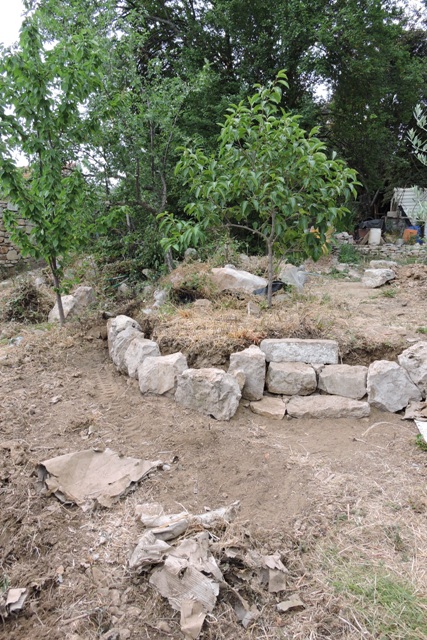
There is no shortage of stone, it is trying to find the right stones to fit in the right place.
The design on paper was quite easy with some nice sweeping curves. I find doing the artistic bit, selecting the right stone for a particular place, with the right face to the outside both enjoyable and theraputic.
However like everything, it has to be done in stages.
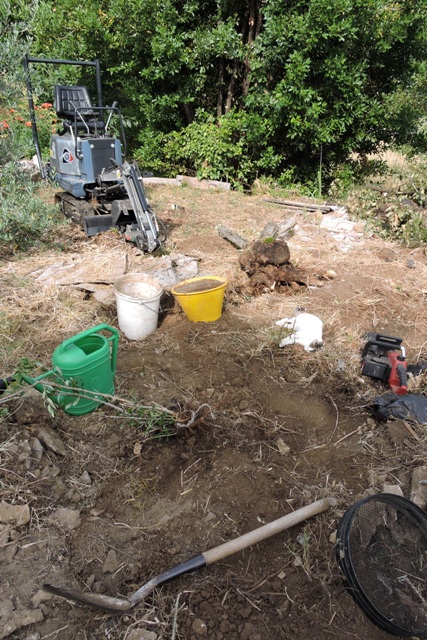
I use my Velika Maška digger to clear the earth embankment and make the space for the stones. Then I move a few stones into place and repeat the process.
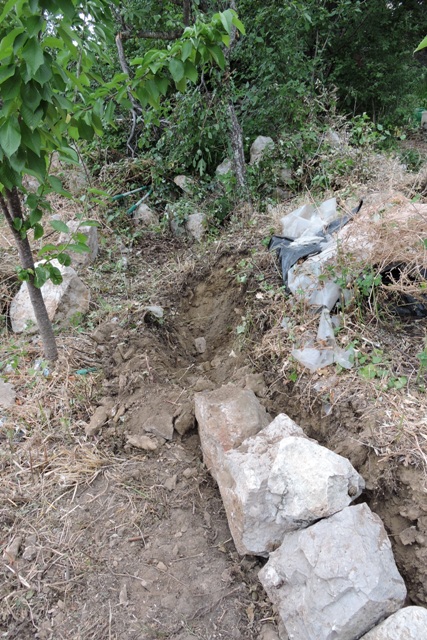
You can see from the photographs just how dry the soil is and the amount of stone it contains.
These are just the bottom row for now. There will be smaller stones on top later but the important job at the present is to get the base of the rockery into position.
Quick, mark the calendar!
I’ve been thinking, it doesn’t happen very often so put a ring round the date on the calendar….
It all started because I have launched a Facebook Group for Hvar plants and flowers – Hvarsko grmlje i cvijeće.
There are Facebook groups for every activity, sport, hobby and pastime that you care to think about.
It seemed that a good way for people with an interest in the island, in our flora or Mediterranean gardening in general, would be to meet via a private Facebook group, dedicated to the subject.
Partly this is because there is no book specifically about our island’s wild and cultivated plants and flowers, although there are many which cover all or part of the Mediterranean biome.
To make it useful for people, I created a bibliography of books and also an exploration of the different ways countries assign “climate zones” to areas, to describe plants for places with the same growing conditions.
In one such study, I saw that where I live now and where I used to live, on the north east coast of England, were classed as being in the same zone!
The North Sea warms to around 14ºC in a really hot summer. The Adriatic sea, which I can see from home (just, with binoculars) cools to around 15ºC in winter.
So yes, as I look at at my fig trees, olives, Lantana flowers and listen to the first of the 2022 Cicadas that have just hatched, I can see how that decision was reached, not!
This led me to explore Mean temperatures, or do I mean Average temperatures?
Which in turn led on to discovering the four cardinal temperatures for successfully growing tomatoes, and so on.
So as I sat listening to the sound of an occasional Nightingale calling, drifting in through the open windows; the sound of a light cooling breeze rustling leaves on the grape vine outside and the occasional chirruping of a Cicada, I realised the rest of the world around me was asleep while my grey matter was churning.
I must stop doing all this thinking….
Talking of nightingales…
I’m usually up early in summer, because it is cool working outside before 8am.
The warm orange light of dawn seeps through the windows from 4am. A veil across the north eastern sky, steadily brightening as sunrise approaches is a signature of long Mediterranean days.
Tuesday this week was the northern Summer Solstice, with twilight beginning at 03:53, an hour and a half before sunrise at 05:15. It is then another 15 minutes or so before the sun appears above the distant alps.
I wanted to try and capture this pre-sunrise light show.
Sadly my photographs do not do justice to the soft light and colour graduations above the Dinaric Alps on the distant mainland.

I had tried to sneak out of the garden without the felines knowing, as my vantage point to watch the sun rise is up in the Maquis, some distance from home.
I failed, although I only had two companions with me for the walk.
After the sun appeared from behind Svete Jure, the highest point in the Bikove National Park, I set off back home for breakfast.
The path through the Maquis is cool at this time of day, as it runs between pines and oaks, with a high wall on the up hill side and abandoned terraces on the down hill side.
We were being followed by a couple of birds calling with a single repeated note.
They were hidden in the tree canopy and I thought that it was an alarm call because of the cats cavorting at my feet.
As the path opens up, some 100 meters from home, the two birds emerged and perched on some dead branches, still calling, bobbing up and down as they called.
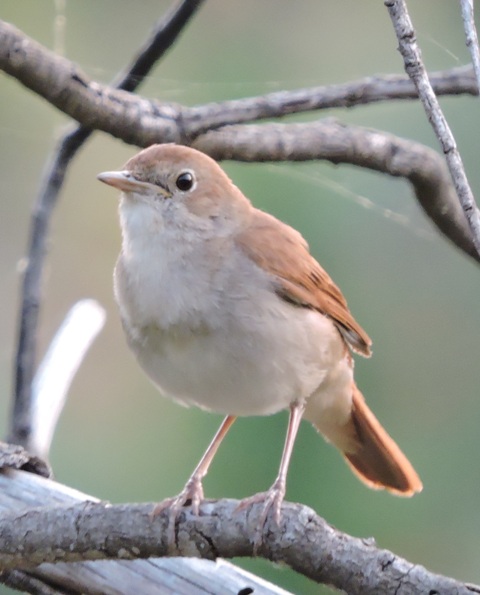
I took a few photographs and then continued, shooing the felines along because they had started to take an active interest in the birds.
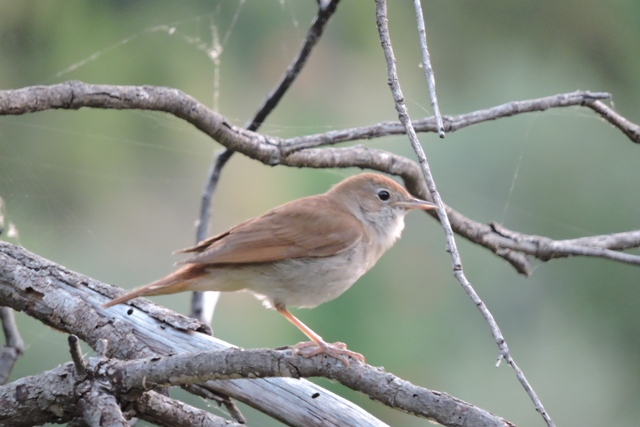
Sending the photos off to Steve, my ornithologist friend, I was surprised when he told me they were juvenile Nightingales.
The Nightingales arrived on 22nd March this year, a little earlier than previously and have been singing their hearts out ever since, even now as I write this.
I often hear them, but even when I can identify their perch, they remain invisible in the trees and if I edge closer to try and see them, they stop singing.
So seeing these two fledglings is a rare treat. I have heard the same calls from a tree in my orchard, where I thought Nightingales might be nesting, so it seems I was right.
Nightingales nest close to or on the ground, in impenetrable thickets or low down in trees. It is so nice to know that some of our pairs have had a successful breeding season.
Later in the week I had four juveniles simultaneously calling from around the orchard, with at least one adult replying from somewhere in my tree.
So it would seem as though 2022 was a very successful breeding season.
Jamming session
A lot of fruit seems to all come ready at once. This week it is plums, apricots and cherries.
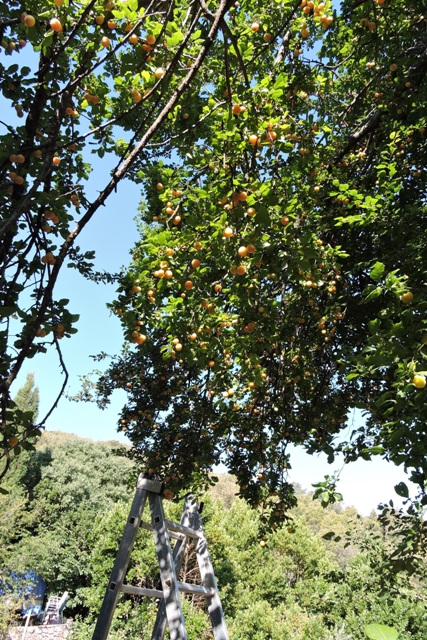
I have picked several buckets of yellow plums with the help of a step ladder. Even so a lot of the fruit has fallen and more remains too hight up for me to easily reach.
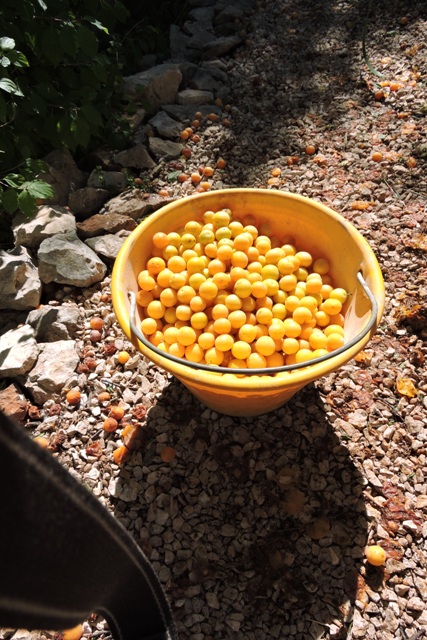
After bottling some plums for the coming winter, I filled plastic bags and gave them to friends and neighbours.
Without any shadow of a doubt, 2022 has been the best year for plums since I moved here.
Identifying quite why that might be is not something I am able to do though. Certainly the mild temperatures at blossom time has allowed a lot of fruit to set.
I also filled a bucket with apricots.
This is from a young tree which I planted four years ago. Clearly it likes where it is in the orchard because it has rewarded me with around `15kg of fruit.
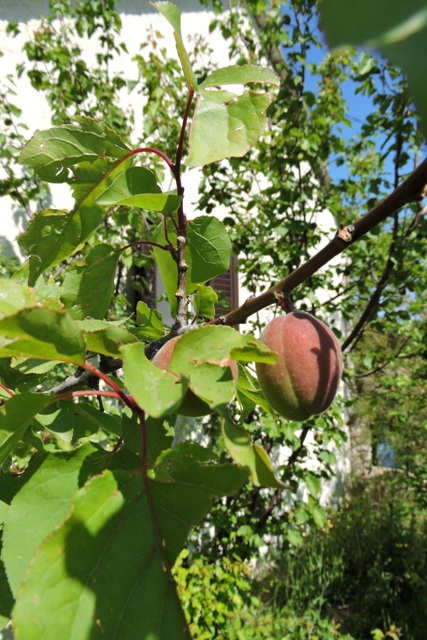
The apricots are sweet and juicy, so some have been eaten straight from the tree, I took a bag round to my neighbours and the rest I settled down one afternoon this week, to preserve by bottling.
I find jamming difficult. Then you use it in bread and toast…
It just seems that there are so many steps involved in getting everything just right for jam, so that it sets, but then I was never eligible for the WI!
Whereas I have always preserved fruit by bottling in Kilner jars, or now in the screw top glass honey jars, which otherwise would go for recycling.
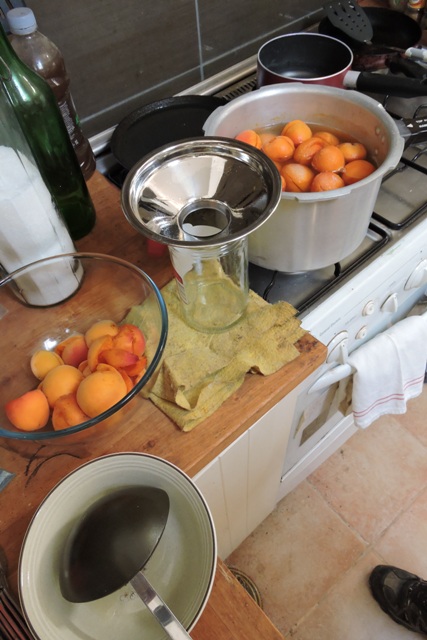
Preparing the fruit, using a pressure cooker pan to bring a light syrup to a boil and then sterilising jars and lids before filling each jar, is a little time consuming.
However the results of my endeavours will be enjoyed in pies or as stewed fruit over the coming winter. Bottling seems to allow more flexibility in their later use for less initial effort.
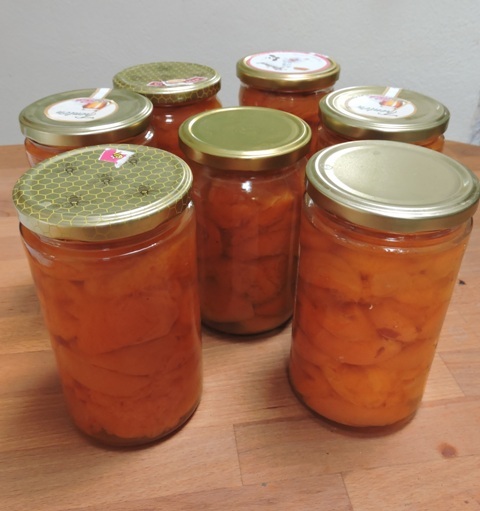
In all I have bottled 12 kilogrammes of fruit which again, is a near record. Soon it will be the turn of my red plums…
Insects a plenty
Every year I enjoy observing the insect life which shares the land around my home and every year I see new species.
As I was watering my Greengage tree in the courtyard, my eye was drawn to a striking green caterpillar which was gently munching on a leaf.
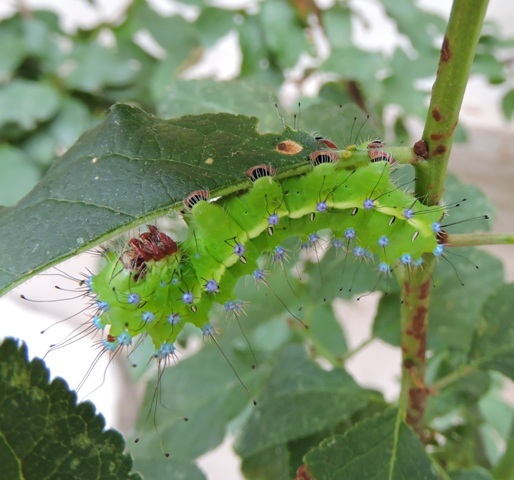
I’ve not seen one like this before. It was large, about five centimetres long and with very distinctive, bright colours. You just don’t see green caterpillars with bright blue tubercles very often!
If I hadn’t seen the mouth moving, I would not have been sure which end was which.
With colours like this, I had expected it to be easy to identify but after spending quite some time online, I couldn’t. Well, I couldn’t identify it with certainty that is.
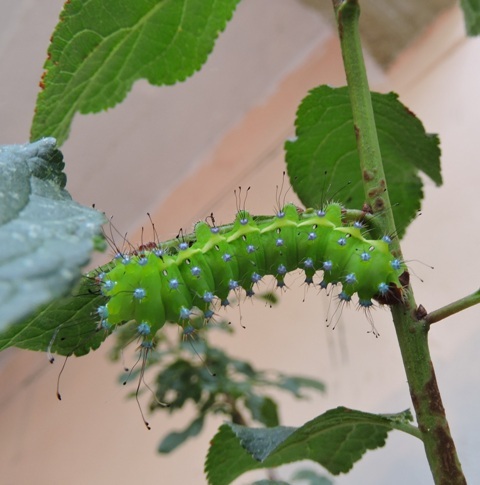
I eventually found a similar looking caterpillar, but it was an American species.
Delving further into the world of green caterpillars, I discovered the Japanese Oak Silk Moth, Antheraea yamamai. This is a species imported from Japan to Europe for the production of silk and is now found wild throughout the Balkans and as far north as Austria.
This looks very much like the Second Instar of this large moth’s caterpillar.
I’m still not sure, because the internet says it feeds on Oaks. There is no mention of Prunus domestica so I have asked for help to confirm the identity. There was only one on the tree, so I have left it to its munching.
I came across a new Katydidthis week as well.
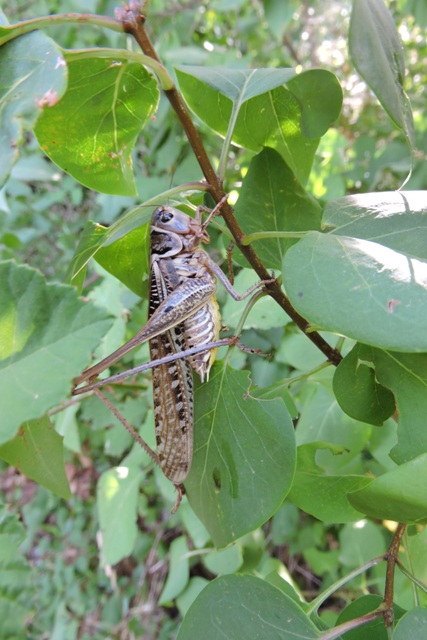
Bush Crickets are all over and they come in a huge range of colours and sizes, but this chap stood out because of the length of his wings.
Called the Grey Bush Cricket in English, Platycleis grisea, it lives on the edge of the Maquis so should be right at home around my home.
I was also lucky to find a newly hatched Cicada this week too.
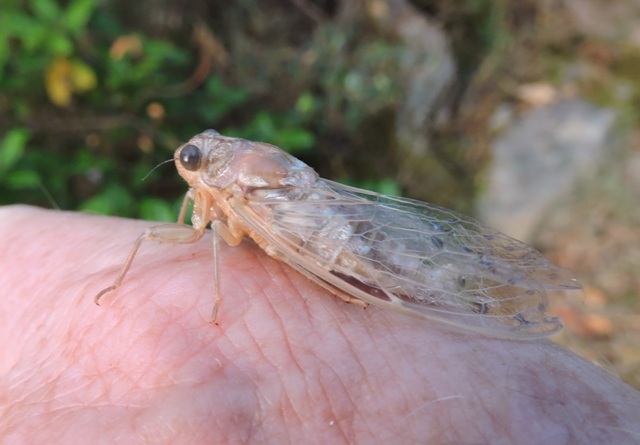
The first Cicadas emerged just a week ago and this example was still waiting for its wings to harden.
You generally can’t get close to them because they are adept flyers, however he was happy just to sit on my hand. I left him in a sunny spot on one of my trees.
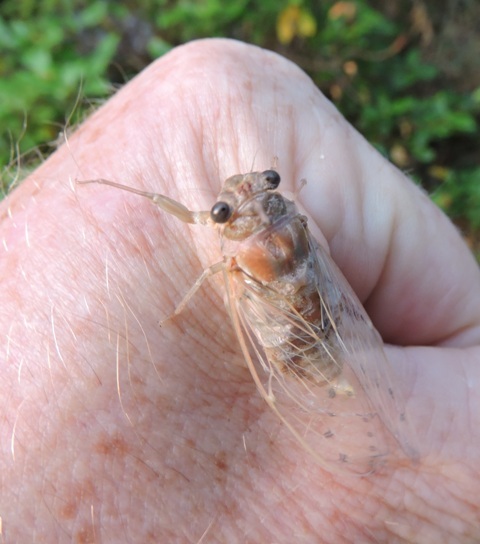
Finding disease
In the middle of the week while working in the orchard on the new rockery wall, I got hold of the trunk of the old olive tree.
I was surprised when the substantial trunk moved easily and I was able to just pull it out of the ground!
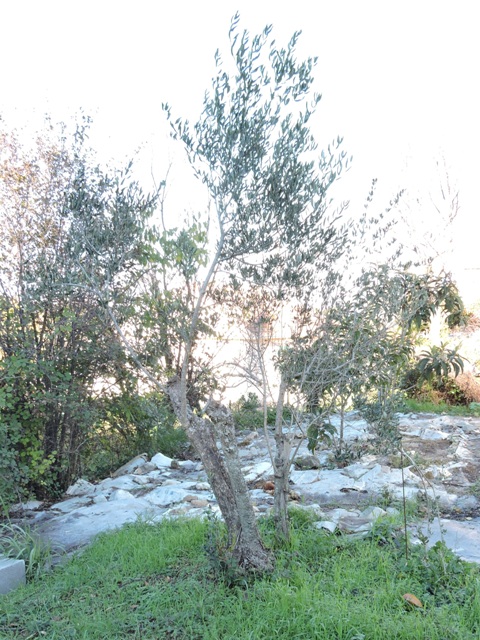
When I pulled on the trunk, it came out of the ground easily.
Even with my very limited experience of olives, I could identify that the roots were rotten, dry rot rather than sticky wet rot though. Then there is the white spongy mass of a Mycelium fungus. My thoughts were that it is terminal.
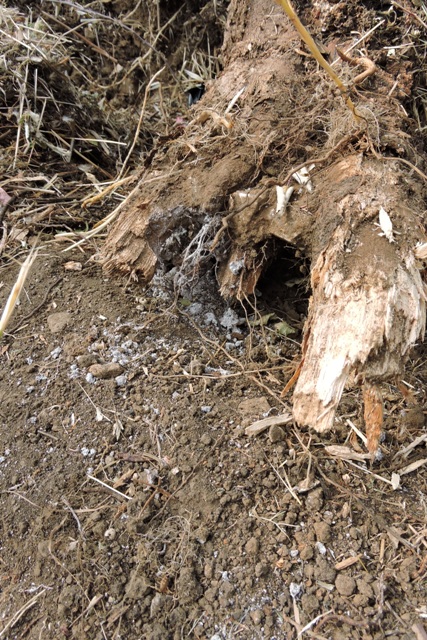
You just should not be able to just pull a tree of this age and size, out of the ground!
My next door neighbour who has lived here many years and has a number of olive trees came to my rescue with sage advice.
We spent a couple of hours early on Friday trying to save some of the side shoots where there are some strong roots.
Using a chain saw to slice through the thick but soft stump to find some hardwood wasn’t difficult. This resulted in three pieces which had a number of live shoots that I replanted after being dug up.
My neighbour had suggested replanting straight away, however the soil is very dry and there is no rain on the horizon, so I decided to pot them individually where I can exert more control over their environment.
In large pots, these shoots will need a lot of TLC to encourage some strong root growth, so I have moved them to a nursery area where I can look after them.
I knew there was something wrong with this tree, but I didn’t know what. In my time here, it has never had a single olive on it, no matter how it was pruned and treated.
It is a very old tree, judging by the size of the stump in the ground, going back 75, 100 years probably. I’ll know when I count some rings, but when I saw flowers this year, I thought it might have turned a corner.
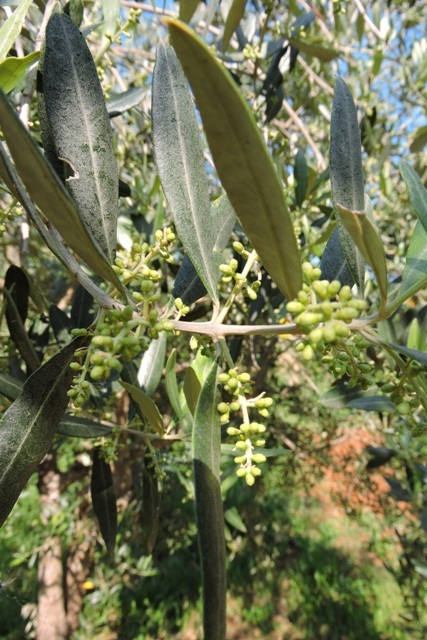
It wasn’t long before all the flowers had fallen. Now on a newish tree, which didn’t have the root system developed, I could understand the flowers failing to set fruit, but not on such an old tree.
So I am not surprised to have found the extensive root rot.
What I am now trying to establish is whether I can plant anything else there, in case the Mycelium bacteria has contaminated the soil.
I’ve asked some online sources for their views and await their answers before my next step. NCG
3 Responses
Steve
Victoria says she will swop you her home made strawberry jam for your apricots. Just a matter of distance to overcome!!!
Best wishes. Victoria and Steve
Elizabeth Blackledge
I have always found jam fairly easy, but have never tried preserving fruit apart from once doing a rumtopf of mixed fruits. The trick with the jam is reducing the liquid by simmering and having enough pectin to get it to set. ‘Jam sugar’ has pectin added but you can use ordinary sugar and add commercial pectin if you need. It really depends on the fruit you are using. Just found this chart, which thought you might be interested in, might help you overcome your jam worries!?https://www.kilnerjar.co.uk/acidity-and-pectin-chart
Michael Southall
Hi Norman,
Your amazing caterpillar looks good for Saturnia pyri, the Giant Peacock Moth. You are in the range of the species.
Regards
Mike